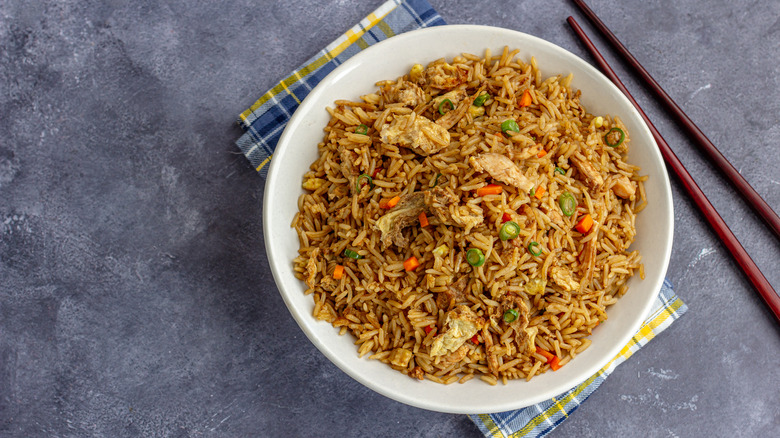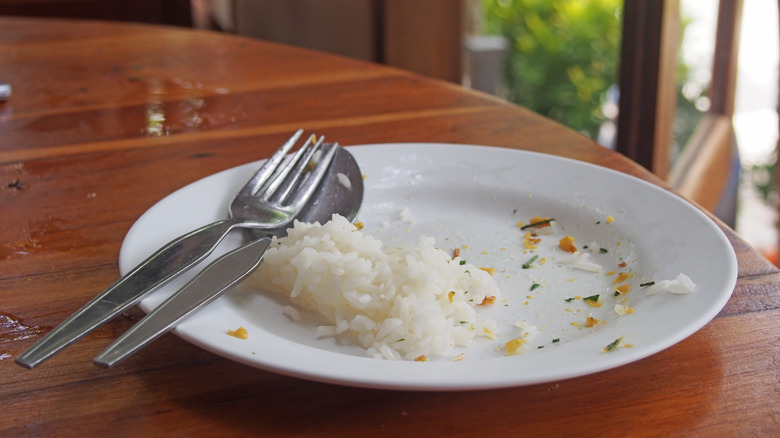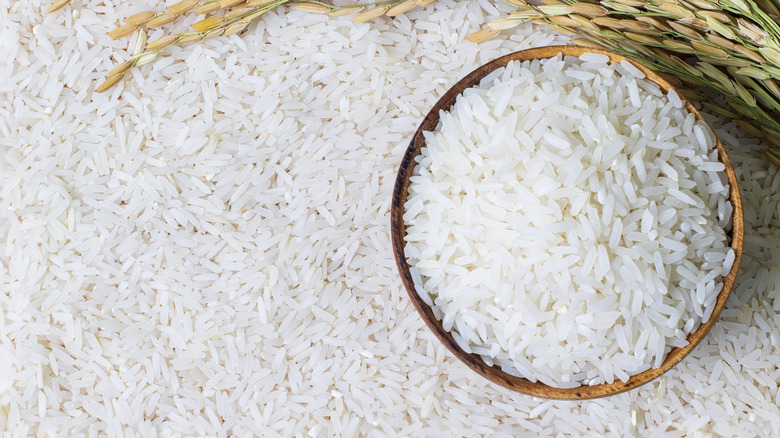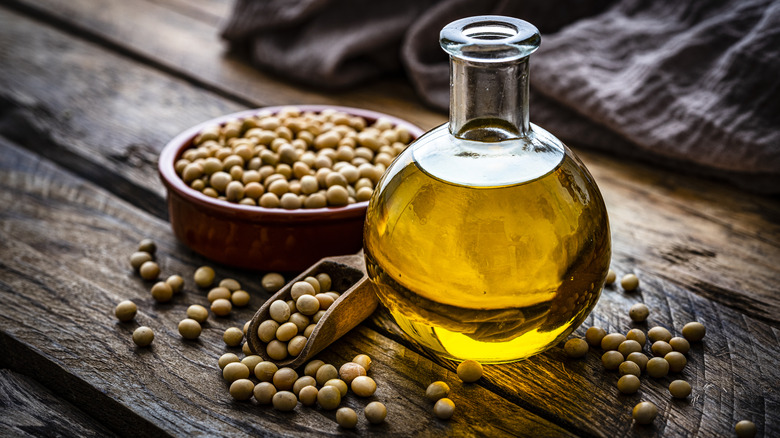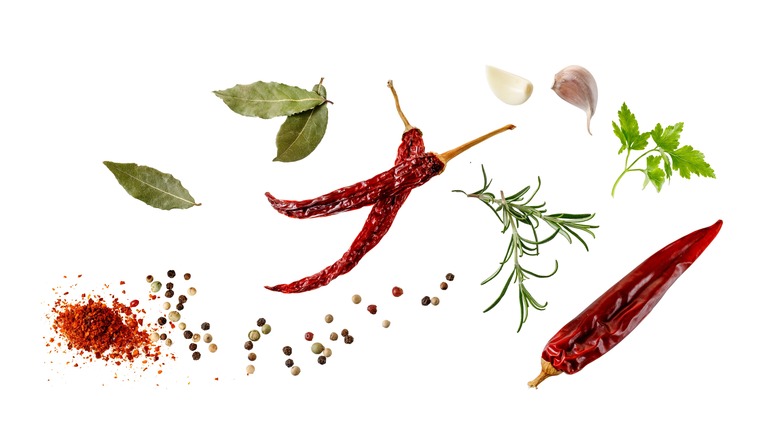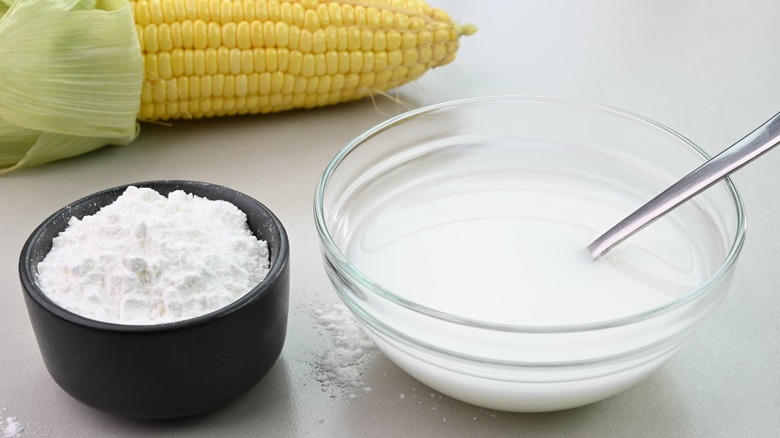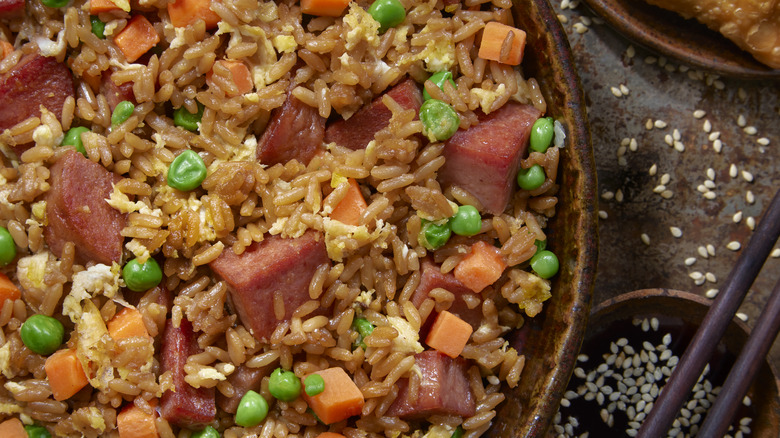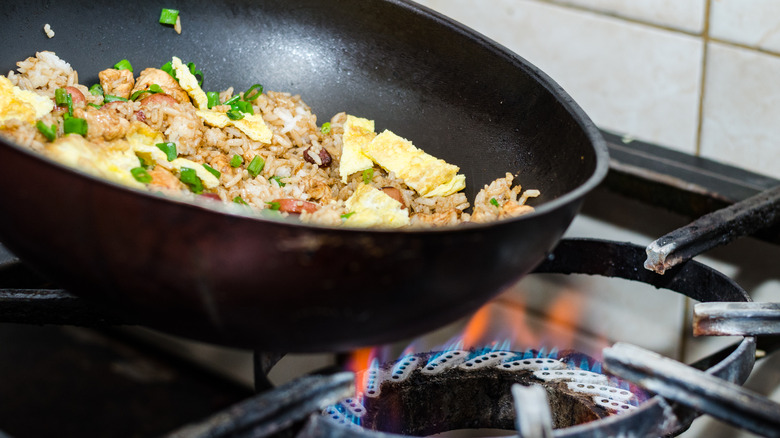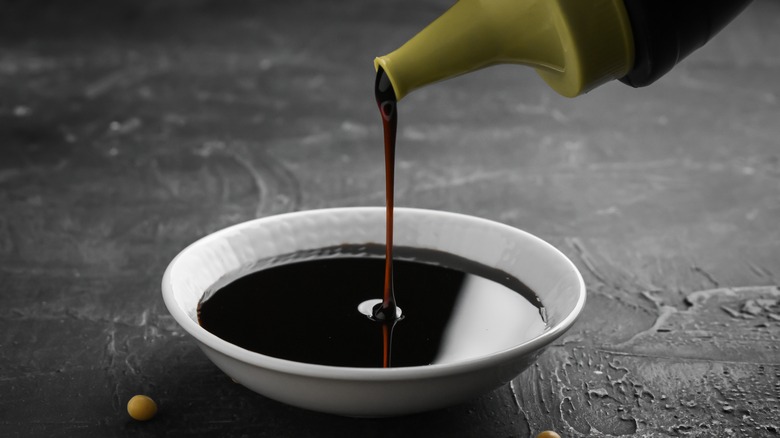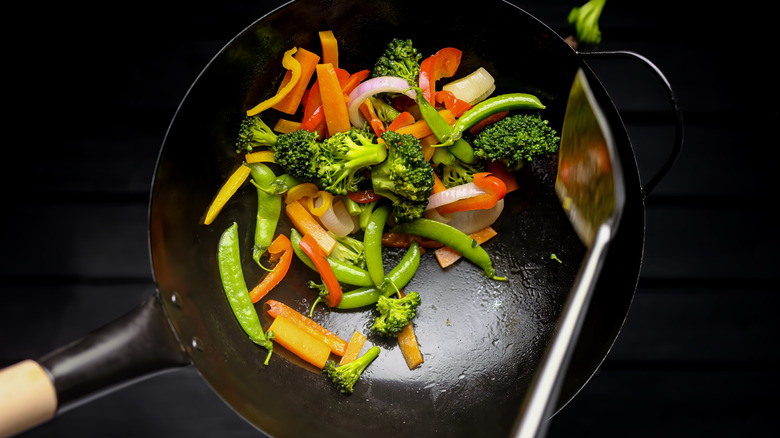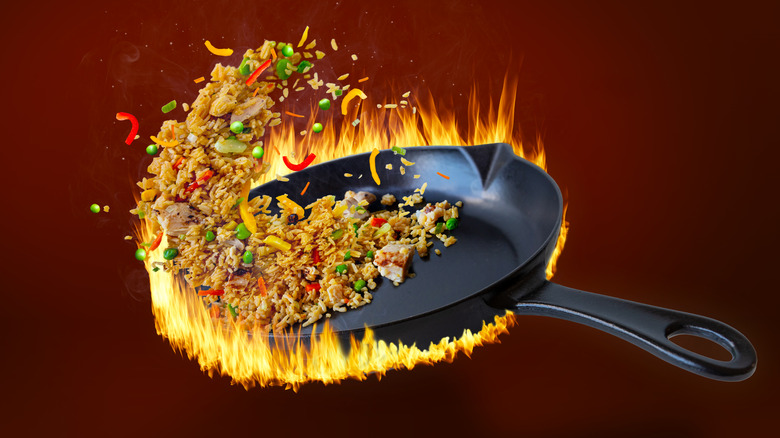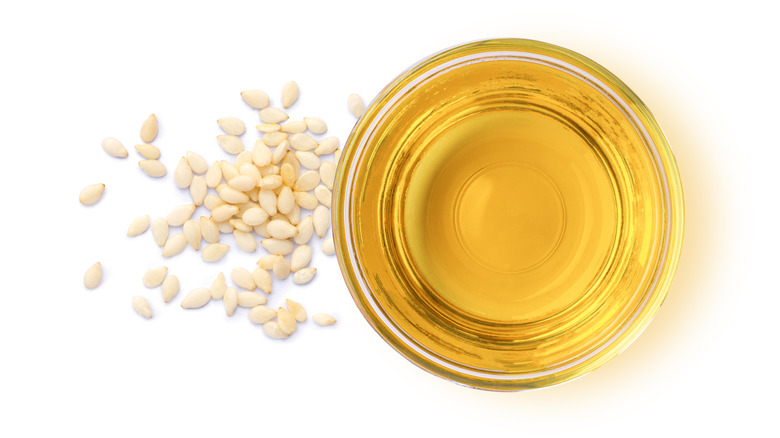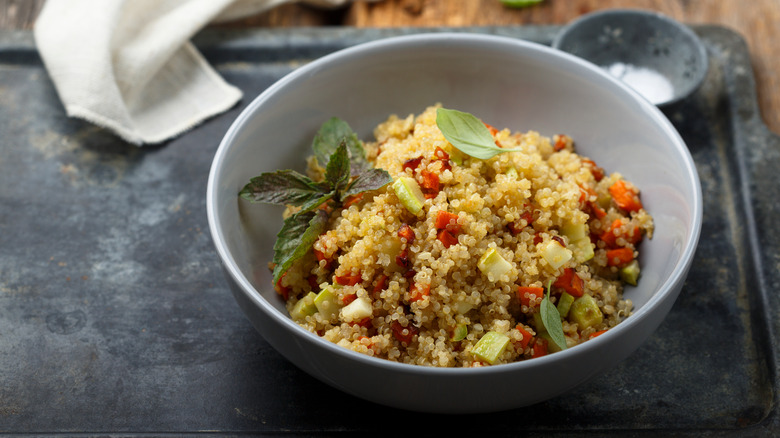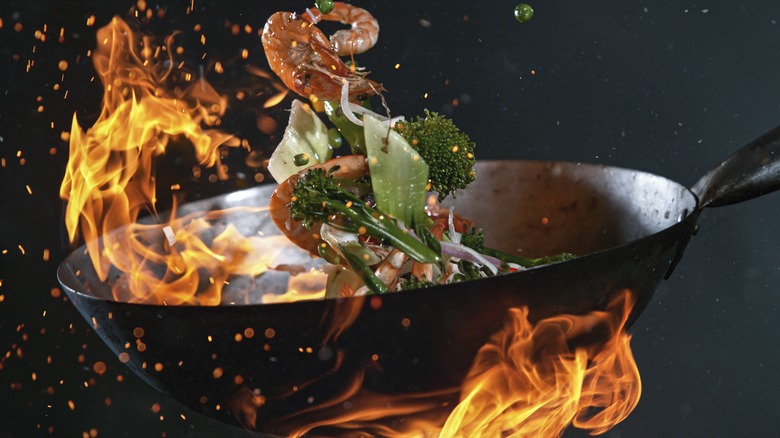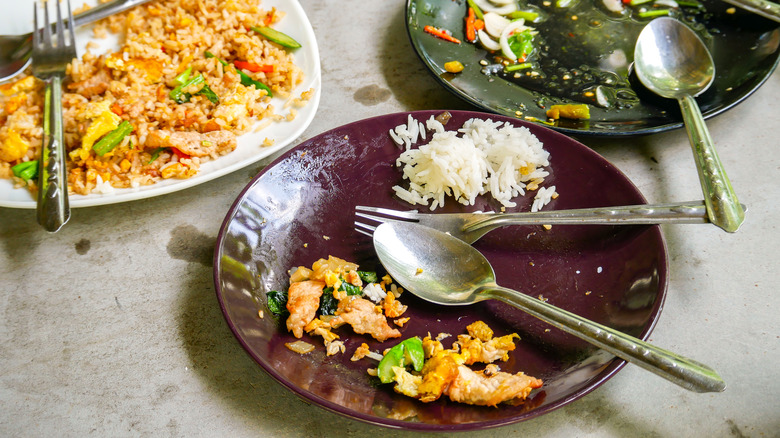15 Tips You Need To Make Restaurant-Quality Fried Rice At Home
Fried rice is one of those dishes that soothes the soul. Warm, comforting, versatile, and flavorful, fried rice probably originated in China in the sixth century as a way to use up leftover rice. Since then, it's evolved into many different variations that are available all around the globe.
What's your favorite place to eat fried rice? Chances are it's a Chinese restaurant where seasoned chefs are whipping up plates of this classic, delicious dish in a professional kitchen. But what if I told you that you don't need to order from a restaurant to taste the finest fried rice because you can make it in your very own kitchen?
Making restaurant-quality fried rice may seem like a tall order at first, but with the right knowledge, you can rest assured that you'll be serving it up in no time. Read on to find out about the best ways to get your fried rice to taste the way it does at your favorite restaurant.
Use day-old or leftover rice
Cold rice that's been sitting in the fridge overnight hardly sounds like an appetizing way to start a restaurant-quality meal. If you've ever eaten cold, leftover rice, you know that it tends to be dry, firm, and starchy, which isn't exactly delicious for snacking, but it's perfect for making fried rice. One of the biggest pitfalls when you're making fried rice is that it can turn mushy and clumpy, so you want to do what you can to keep your rice dry during the frying process.
Day-old, refrigerated rice is drier than freshly cooked rice, so it is less likely to get soggy. If you go out to dinner and have some rice leftover at the end of the meal, get a to-go box to make easy fried rice the next day. You can also make a batch of rice a day ahead and put it in the refrigerator overnight to use the next day. And if you're really wild about fried rice (and you should be), you can make a big batch of rice and throw it all in the freezer and when you're ready to thaw it out for fried rice, just throw a chunk in the pan and get cooking!
Medium-grain rice is best
All rice was not created equal. From jasmine to basmati to glutinous, it seems like there are infinite options when it comes to choosing which type of rice you'll use to fry up for a restaurant-quality plate of fried rice. But not so fast! It turns out that the best kind of rice to use for fried rice is medium grain, like jasmine rice, which is used in Thai cuisine, or regular medium grain white rice. It possesses the perfect plumpness, remains chewy after it's fried, and doesn't tend to break apart or get mushy as much as some other kinds of rice.
Basmati rice, for instance, which is a long-grain type of rice often used in Indian cuisine and is perfect to use for a classic rice pudding, just doesn't hold up in the context of fried rice. The grains are likely to become hard and dry during the frying process. On the other end of the rice spectrum, short-grain sushi rice is starchy and tends to clump together, making it difficult to toss and stir to give you that nice, crispy, light, fried rice you're used to eating at restaurants.
Turn the heat up
You wouldn't expect to eat mushy fried rice with soft vegetables at a restaurant. And one of the easiest ways that they avoid clumpy, soupy fried rice is by keeping the heat turned high on your stove throughout the cooking process. This ensures that the moisture evaporates out of the pan while the rice is being cooked instead of getting caught in the grains and turning them into mush. You need the rice to fry instead of steaming to give it that fluffy texture and slightly brown color.
And it's not just the rice that benefits from being cooked at a high temperature. Whatever vegetables you decide to add to your fried rice, you want them to get nice and crispy. Suppose you cook them at too low a temperature. In that case, the vegetables are likely to get mushy and soft, and instead of providing a nice, crunchy textural contrast to the rice that forms the bulk of the dish, they can disintegrate into the rice, and you can end up with a big, gooey mess.
Fry your rice in oil with a high smoke point
When it comes to making restaurant-quality fried rice, oil is a key ingredient. But you can't just use any old oil you happen to have on hand. Since making fried rice requires high heat, the best oils for fried rice have a high smoke point: The temperature at which the oil begins to break down and start smoking (which is not what you want when you're cooking). Although almost everybody has it on hand in their kitchen, olive oil's smoke point is relatively low, which means it's not the best option for fried rice. It also has a strong taste, which only sometimes combines well with the other flavors in fried rice.
There are plenty of other oils that make great options for fried rice, though. It all depends on what you're looking for. For a neutral flavor, you can use canola or vegetable oil. If you'd like to impart a slightly nutty taste to your fried rice, we suggest you go with peanut or sunflower seed oil. One of the oils with the highest smoke point, avocado oil, has fruity undertones and isn't bitter or acidic, and it happens to be one of the healthiest cooking oils.
Cook your aromatics first
Fried rice is all about infusing your rice with lively flavors to give you a meal that's affordable, nutritious, and packs a tasty punch. And it's not only the ingredients that you choose to use in your fried rice but how you use them. To get restaurant-quality fried rice at home, it's essential to use aromatics, a group of vegetables and herbs that are so named because they lend your dish a distinct aroma. Common aromatics that are used to flavor fried rice are onion, garlic, ginger, lemongrass, and red peppers.
The reason aromatics are so important when cooking is because they release flavors that give dishes an incredible depth and complexity. And when you're cooking fried rice, it's important to cook your aromatics in oil before anything else hits the pan because it gives them a chance to release their flavors into the oil. Once you fry the rice, the flavor-loaded oil coats the grains and gives you a finished product that is every bit as delicious as what you're used to at your favorite restaurant.
Add a dash of cornstarch
As we've discussed, too much moisture is the enemy of a successful plate of fried rice. There are several tactics you can use to make sure you're actually frying your rice as opposed to steaming it, but one tried and true hack that can level your fried rice up to restaurant quality is using a dash of cornstarch. Cornstarch is a powder derived from the corn plant that, when heated, is excellent at absorbing moisture, which is why it's often used for thickening sauces and coating meat before it's fried.
Adding a dash of cornstarch can improve fried rice by preventing the grains of rice in fried rice from getting soggy and mushy. Because it's more effective at absorbing water than rice, the moisture in the dish is naturally attracted to the cornstarch, which keeps the rice nice and dry and leaves you with those loose grains, which make for an ideal texture for fried rice.
Get creative with your ingredients
One of the most important rules for choosing ingredients to put in your fried rice: Forget the rules. Fried rice is all about improvising and making kitchen magic with whatever you have on hand, so when you're following a recipe for fried rice, it's important not to take it too seriously. Although some classic ingredients are time-tested and widely beloved, like carrots, red peppers, onions, and chicken, who's to say that you can't throw something a little more adventurous in the pan?
If you've got some recent leftovers crowding your refrigerator, mixing them with rice and adding them to scrambled eggs for a tasty fridge cleanout is a great way to make a delicious meal while freeing up some valuable real estate in the old icebox. The base ingredients of fried rice — eggs and rice — are incredibly versatile, which makes them a blank canvas for culinary creativity. Got a vegetable stir fry from yesterday's lunch? How about the rest of that steak you couldn't finish at the chop house? Throw it in the pan with some aromatics, eggs, and rice, and enjoy your delightfully unique creation.
Scramble your eggs separately
When you're making fried rice, you can't just throw all the ingredients in the pan and expect it to come out like the fried rice you're used to eating at a restaurant. Although it's important to get creative with your process, there are some basic rules that you should follow if you want to end up with restaurant-quality fried rice, and one of them is to scramble your eggs separately from the rice.
If you're not keen on dirtying more than one pan, one easy fried rice recipe suggests that you can use the same pan for your vegetables, eggs, and rice, but you need to make sure the eggs have their own space to cook. If you push the rice mixture to one side of the pan, you can give them room to scramble them on their own and then easily mix them in with the rest of the ingredients once they've firmed up enough not to turn your rice gooey.
Don't forget to use seasoning
Once you've got your fried rice mixed up with eggs and vegetables, you might think the work is done, but there's still one more important step that can make or break a plate of fried rice: the seasoning. Soy sauce is perhaps the most common seasoning used in fried rice, but there are plenty of other options.
If you're going for a tangier, funkier flavor, you can use fish sauce, which packs a serious salty punch, so be sure not to add too much salt early on in the cooking process so that you can fine-tune it at the end. If you want something a little sweeter, squeeze a bit of hoisin sauce over your rice, which is sticky and sweet, which can provide a nice contrast to crisp, salty vegetables. Some people even swear that sugar is the secret ingredient for fried rice that rivals takeout, and that you can use in its granulated form or even drizzle a bit of maple syrup right before the rice is ready to serve.
Don't overcrowd the pan
To achieve a truly gourmet quality plate of fried rice, you have to make sure you're cooking the ingredients quickly and evenly to get them nice and crispy, so be sure to put only a little in your pan at a time. It's well known that overcrowding your pan can ruin your cuts of meat because it lowers the temperature of the pan, which prevents the outside of the meat from searing, so you don't end up with that slightly crunchy, umami flavor that is the hallmark of a nice piece of meat. Overcrowding the pan also traps moisture in the rice, which can make it clumpy and soggy.
So, if you plan on making a large amount, it's best to make fried rice in smaller batches. Restaurants typically have big burners that can accommodate huge batches of rice, but if you're cooking at home on an average stove, you shouldn't add more than about one cup at a time.
Stir or toss your rice continuously
Delicious fried rice relies on technique as much as it does on ingredients. If your fried rice keeps turning out soggy, you may not be giving your pan enough attention while your rice is frying. In order to keep the rice dry and crisp, you've got to keep your rice moving around as it cooks so that it has a chance to release its moisture into the air. Also, since you want to cook your rice at a very high temperature, you need to keep it from sustained contact with the bottom of the pan so that it doesn't burn.
While stirring is perhaps the easiest method, if you're using a wok or a deep pan and you're confident in your hand-eye coordination, you can do one better and toss your rice as it's cooking. In fact, in many Chinese restaurants, chefs are trained to toss fried rice instead of stir because it keeps the rice moving and prevents it from getting soggy and burning.
Add sesame oil
There are certain ingredients that you can add to your fried rice that will give it the deep, complex flavor that you associate with fried rice that you order at a restaurant. Sesame oil is one of those key ingredients that distinguishes amateur chefs from fried rice connoisseurs. A common addition to Chinese cooking, sesame oil is one of the best oils to use for extra nutty flavor.
But be sure to pay attention to whether you're using regular or toasted sesame oil, which packs an extra smoky punch. Either type of sesame oil goes well with fried rice, but regular sesame has a higher smoke point, so you can add it closer to the beginning of the cooking process, while you only want to add toasted sesame oil at the end so that it doesn't burn because of the high heat of the pan. But either one of these sesame sisters is guaranteed to upgrade your fried rice up to the restaurant level.
Try something other than rice
One of the secrets that nobody is telling you about fried rice is that, although it does have to be fried, it doesn't have to be rice. Although it's obviously the most common grain to fry up with eggs and vegetables, there are plenty of other options if you're looking for something with a different flavor or nutritional properties.
If you go with a quinoa fried rice recipe instead of a traditional one, for example, you'll end up with more protein and fiber, and a slightly nuttier taste and chewier texture. Other grains that make great substitutes for the rice in fried rice are farro, which is a bit more savory and earthy, and barley, which has a slightly toasted, sweet flavor. If you're looking to cut the grains out entirely, you can go with riced cauliflower, which you can buy frozen or grate yourself.
Cook your rice in a wok instead of a pan
The real fried rice pros wouldn't even think about using a regular pan to make fried rice. At Chinese restaurants, fried rice is made strictly in a wok, a cooking vessel analogous to a pan traditionally used in China that is shaped like a bowl with a curved bottom. The wok is ideal for cooking fried rice because the heat concentrates at the bottom, and the curved shape makes it easy to toss the rice and keep it moving so that it stays hot and has contact with the air so that it can release its moisture.
The high temperature used in wok cooking is also great for cooking meat because it triggers the Maillard reaction, which is the chemical reaction that occurs when amino acids and sugar combine in the presence of heat to form an umami caramelization that gives the meat an undeniably satisfying outside layer. In fact, in China, this unique flavor and aroma that comes from a wok is known as "wok hei," which translates to "breath of wok."
Know how to reheat your leftovers
If you've mastered the art of making restaurant-quality fried rice, then there's no doubt that you'll be making it all the time, which means you'll probably end up with leftovers. Fried rice can be challenging to reheat in a way that retains the quality of the original dish. You can't just throw a bowl of leftover fried rice in the microwave, for example, and expect it to taste like it was just delivered from your favorite Chinese restaurant.
One of the absolute best ways to reheat fried rice is to place an ice cube on top of your plate of fried rice before you put it in the microwave, reintroducing moisture into the dish, which can dry out after being left in the fridge overnight. Another option is to reheat the rice in a skillet at low heat along with some water or oil to make sure the rice doesn't dry out. Follow these rules, and you can enjoy your fried rice for days.
